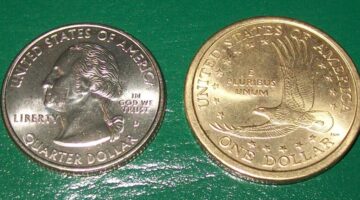Have you ever heard anybody use the term mule coin?
A mule is a type of error coin. It has an obverse (heads side) design and a reverse (tails side) design that wouldn’t ordinarily go together on the same coin.
Mule error coins are particularly interesting pieces. They derive their name from the offspring of a donkey and a horse. This creation (a blending of 2 distinctly different species) commonly serves as a working animal.
While mule coins aren’t necessarily beasts of burden, they are very much analogous to the mule of the animal kingdom — because they consist of 2 coins that wouldn’t typically be together.
Whether they are accidentally struck or intentionally made, mule coins are quite rare.
Mule error coins have long attracted the interests of coin collectors. These coins are high on the want lists of many error coin collectors!
Popular Mule Error Coins
2000 Sacagawea/Washington Quarter Dollar Mule Error
One of the most popular mules is a dollar-size coin showing the obverse of the Washington state quarter and the reverse of a Sacagawea dollar — struck on a dollar planchet in the year 2000.
This mule coin, as it happens, is actually a legitimate error that the US Mint confirmed.
Mint officials say that a Sacagawea dollar coin die cracked in production, and a Washington quarter die was accidentally used to replace the broken die. The discovery happened after thousands of these error coins were made. Most of them were destroyed, however a few apparently got out.
There are 18 of these rare error coins known to exist.
This 2000 Sacagawea dollar coin sold for over $29,900 when it was first found and authenticated. Another of these Sacagawea dollar/Washington quarter mules sold for an astounding $155,250!
1959-D Lincoln Cent Mule
Another popular mule coin is the 1959-D Lincoln cent.
This 1959 Lincoln wheat cent is a rare wheat penny error that’s worth $50,000.
There is only one of them known to exist.
While it has been authenticated by the U.S. government and the coin is genuine — there is actually no record of the 1959-D wheat penny ever being made at the U.S. Mint!
Of course, that doesn’t mean the coin was not made there — but it has left many to speculate that the 1959-D penny error was made as a one-off piece. For example, it may have been struck as a prank, a gag, a dare, or even as an intentional attempt by a Mint employee to make a unique coin that would someday become very valuable.
There’s definitely a lot of mystery behind the 1959-D penny mule!
Other Famous Mule Error Coins
Other mule coins that are known to exist:
- A 1967 New Zealand 2 cent coin with the obverse of a Bahama 5 cent coin
- A dateless British 20 pence mule incorporating old and new designs from before and after the 2008 redesign of British coins
- Several 2010 Winter Olympic coins from Canada are interesting mule coins
How To Find Mule Error Coins
Remember, mule coins are extremely rare — so even if you’re looking through bags, boxes, and rolls of coins for years and years on end, there’s no guarantee you’ll find one.
But there are a few ways you can increase your chances of finding a mule error coin:
- Check bags, boxes, and rolls of NEW coins — Chances are better you’ll find a mule this way, rather than looking at bunches of coins that people have already sifted through.
- Visit estate sales and yard sales looking for coin collections — You may find something unusual this way. Be wary though. Many big “discoveries” made this way turn out to be altered coins or coins with post-mint damage.
- Tell people you’re looking for strange coins — And don’t forget to offer payment for these coins, because people probably won’t just give you free coins and tokens! But you might just find what you’re looking for. (Remember the story of how Leon Baller stumbled upon his 1959-D mule penny?)
Good luck… and happy collecting!





